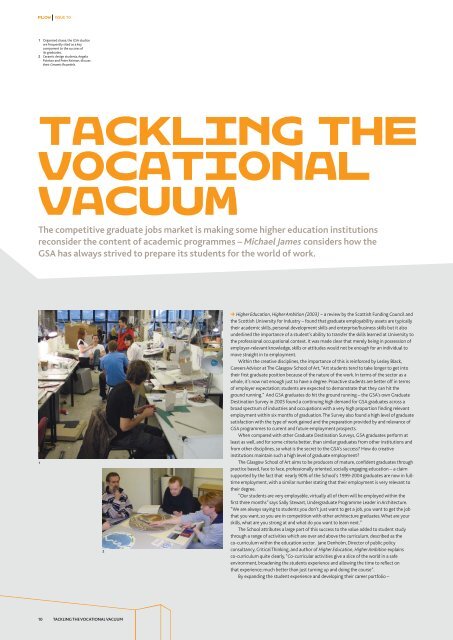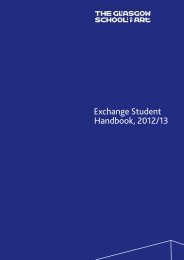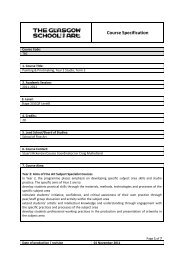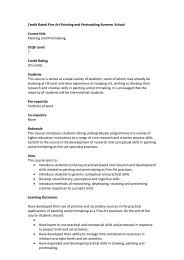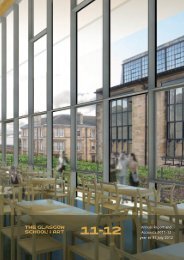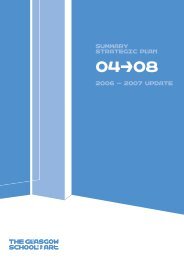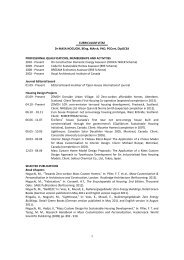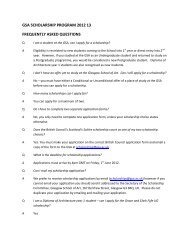Download the pdf of issue 10 - The Glasgow School of Art
Download the pdf of issue 10 - The Glasgow School of Art
Download the pdf of issue 10 - The Glasgow School of Art
- No tags were found...
Create successful ePaper yourself
Turn your PDF publications into a flip-book with our unique Google optimized e-Paper software.
FlOW ISSUE <strong>10</strong>1 Organised chaos; <strong>the</strong> GSA studiosare frequently sited as a keycomponent to <strong>the</strong> success <strong>of</strong>its graduates.2 Ceramic design students,AngelaPointon and Peter Keirnan, discuss<strong>the</strong>ir Ceramic Roundels.TACKLING THEVOCATIONALVACuUM<strong>The</strong> competitive graduate jobs market is making some higher education institutionsreconsider <strong>the</strong> content <strong>of</strong> academic programmes – Michael James considers how <strong>the</strong>GSA has always strived to prepare its students for <strong>the</strong> world <strong>of</strong> work.12> Higher Education, Higher Ambition (2003) – a review by <strong>the</strong> Scottish Funding Council and<strong>the</strong> Scottish University for Industry – found that graduate employability assets are typically<strong>the</strong>ir academic skills, personal development skills and enterprise/business skills but it alsounderlined <strong>the</strong> importance <strong>of</strong> a student’s ability to transfer <strong>the</strong> skills learned at University to<strong>the</strong> pr<strong>of</strong>essional occupational context. It was made clear that merely being in possession <strong>of</strong>employer-relevant knowledge, skills or attitudes would not be enough for an individual tomove straight in to employment.Within <strong>the</strong> creative disciplines, <strong>the</strong> importance <strong>of</strong> this is reinforced by Lesley Black,Careers Advisor at <strong>The</strong> <strong>Glasgow</strong> <strong>School</strong> <strong>of</strong> <strong>Art</strong>,“<strong>Art</strong> students tend to take longer to get into<strong>the</strong>ir first graduate position because <strong>of</strong> <strong>the</strong> nature <strong>of</strong> <strong>the</strong> work. In terms <strong>of</strong> <strong>the</strong> sector as awhole, it’s now not enough just to have a degree. Proactive students are better <strong>of</strong>f in terms<strong>of</strong> employer expectation; students are expected to demonstrate that <strong>the</strong>y can hit <strong>the</strong>ground running.” And GSA graduates do hit <strong>the</strong> ground running – <strong>the</strong> GSA’s own GraduateDestination Survey in 2005 found a continuing high demand for GSA graduates across abroad spectrum <strong>of</strong> industries and occupations with a very high proportion finding relevantemployment within six months <strong>of</strong> graduation.<strong>The</strong> Survey also found a high level <strong>of</strong> graduatesatisfaction with <strong>the</strong> type <strong>of</strong> work gained and <strong>the</strong> preparation provided by and relevance <strong>of</strong>GSA programmes to current and future employment prospects.When compared with o<strong>the</strong>r Graduate Destination Surveys, GSA graduates perform atleast as well, and for some criteria better, than similar graduates from o<strong>the</strong>r institutions andfrom o<strong>the</strong>r disciplines, so what is <strong>the</strong> secret to <strong>the</strong> GSA’s success? How do creativeinstitutions maintain such a high level <strong>of</strong> graduate employment?<strong>The</strong> <strong>Glasgow</strong> <strong>School</strong> <strong>of</strong> <strong>Art</strong> aims to be producers <strong>of</strong> mature, confident graduates throughpractice based, face to face, pr<strong>of</strong>essionally oriented, socially engaging education – a claimsupported by <strong>the</strong> fact that nearly 90% <strong>of</strong> <strong>the</strong> <strong>School</strong>’s 1999-2004 graduates are now in fulltimeemployment, with a similar number stating that <strong>the</strong>ir employment is very relevant to<strong>the</strong>ir degree.“Our students are very employable, virtually all <strong>of</strong> <strong>the</strong>m will be employed within <strong>the</strong>first three months” says Sally Stewart, Undergraduate Programme Leader in Architecture.“We are always saying to students you don’t just want to get a job, you want to get <strong>the</strong> jobthat you want, so you are in competition with o<strong>the</strong>r architecture graduates.What are yourskills, what are you strong at and what do you want to learn next.”<strong>The</strong> <strong>School</strong> attributes a large part <strong>of</strong> this success to <strong>the</strong> value added to student studythrough a range <strong>of</strong> activities which are over and above <strong>the</strong> curriculum, described as <strong>the</strong>co-curriculum within <strong>the</strong> education sector. Jane Denholm, Director <strong>of</strong> public policyconsultancy, Critical Thinking, and author <strong>of</strong> Higher Education, Higher Ambition explainsco-curriculum quite clearly,“Co-curricular activities give a slice <strong>of</strong> <strong>the</strong> world in a safeenvironment, broadening <strong>the</strong> students experience and allowing <strong>the</strong> time to reflect onthat experience; much better than just turning up and doing <strong>the</strong> course”.By expanding <strong>the</strong> student experience and developing <strong>the</strong>ir career portfolio –<strong>10</strong>TACKLING THE VOCATIONAL VACUUM


